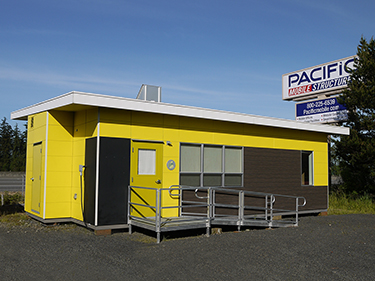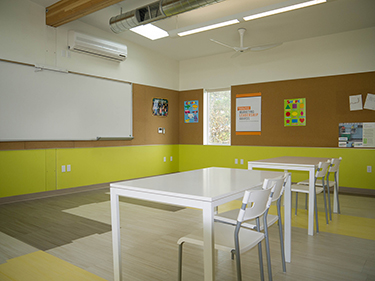|
Subscribe / Renew |
|
|
Contact Us |
|
| ► Subscribe to our Free Weekly Newsletter | |
| home | Welcome, sign in or click here to subscribe. | login |
Environment
| |
 |
September 25, 2014
These modular classrooms are not old school
Pacific Mobile Structures

Allen
|
Most of us remember spending some part of our early education in a modular classroom; a common solution for school districts looking to address space needs in a fast turnaround time and with a low budget.
Created as a short-term fix, these structures were often built to meet the minimum construction standards, with little natural light and cramped quarters.
But what if you could transform the simple concept of a modular, relocatable classroom into a space that is beautifully made, long-lasting, environmentally kind, and most importantly, healthier for students and teachers?
Enter the Smart Academic Green Environments (SAGE) classroom.
The SAGE classroom was designed by faculty and students at Portland State University’s School of Architecture with the support of a broad coalition of partners — including Chehalis-based Pacific Mobile Structures, the Portland Chapter of the American Institute of Architects and Blazer Industries — to create a cost-efficient “green” modular classroom.
This summer marked an important milestone with the Edmonds School District making a commitment to healthier learning with the installation of nine SAGE classrooms across five campuses for the 2014-15 school year.
Natural light and air
Children in these classrooms will be exposed to four times more natural light, 100 percent fresh air and 150 percent more air circulation compared to a traditional modular classroom.
Studies have shown that children have more academic success in learning environments where they are exposed to more natural light and are allowed to look outside and then refocus on their work. The SAGE classroom provides that environment.
With the constant exchange of fresh air and building materials with virtually no VOCs, these classrooms will keep the teachers and students healthy year round.
Long-term gain
For the district, the SAGE classroom will use up to 50 percent less energy than an average modular classroom and has an expected lifespan of 50 to 60 years.
SAGE is made with environmentally friendly materials and a manufacturing processes that minimizes material waste. The overall building process takes approximately half the time for building occupancy than standard construction practices.
LEED certifiable
The SAGE interior has an energy-efficient ERV (energy recovery ventilator) mechanical system, low-velocity fans, vaulted ceilings and continuous dimming lighting. The interior also has BioPCM phase change material in the walls that act as a thermal mass to stabilize indoor temperatures. The steel floor structure allows for a door threshold that is closer to the ground, reducing the costs associated with relocation, maintenance, foundation, stairs and ramps.
Options also exist for solar-powered coolers to eliminate the need for air conditioning, LED pendant lighting and restrooms. The building was also designed to be LEED certifiable.
Exteriors have a modern architectural look with large overhangs to protect the building and Hardie reveal siding. The clerestory windows allow the buildings to be sited to take advantage of the most natural daylighting, reducing the amount of energy used on interior lights. The buildings use an exterior mechanical room that not only houses the ERV unit but also allows the district to enclose a communication link to monitor building performance.
In addition to the nine classrooms installed for the Edmonds School District, another SAGE will be installed at the Corvallis Waldorf School in Oregon. This SAGE was redesigned by Portland State’s Margarette Leite at a size of 28 by 64 feet and includes three separate classrooms.
The building will have a monitoring dashboard to track performance and direct continued innovation and growth. The dashboard will:
• Monitor CO2 for air quality
• Monitor thermal comfort levels
• Periodically evaluate occupant interactions with HVAC and lighting controls
• Test for thermal leakage of the envelope
• Monitor lighting levels
• Test performance metrics of building materials
• Test overall occupant satisfaction
The SAGE classroom is a solution that turns the idea of a modular classroom into something that will be a long-term, cost-beneficial and energy-saving solution for school districts and a learning environment full of light and fresh air that parents and educators will be proud to have their kids in.
Patrick Allen is the head of the SAGE program for Chehalis-based Pacific Mobile Structures.
Other Stories:
- Passive House finds a permanent home in the Northwest
- Survey: Landau Associates
- Survey: HWA GeoSciences
- Survey: Eco Chemical
- Survey: Environmental Resources Management
- Survey: WISErg Corp.
- Survey: Environmental Sciences Associates
- Survey: Farallon Consulting
- Local firms invent modules to protect Louisiana coast
- Old mining pond becomes new salmon habitat
- Time to jump on contaminated urban properties?
- Tackling toxics with green chemistry
- How biosolids can curb greenhouse gases
- Lower Duwamish: watershed management poster child?
- Is hard water drowning Eastern Washington’s economy?
- Preserving Seattle’s largest forest takes a group effort
- Being green is not just about checking boxes
- Carbon-rich tidal wetlands down, but not out
- Survey: Herrera Environmental Consultants




